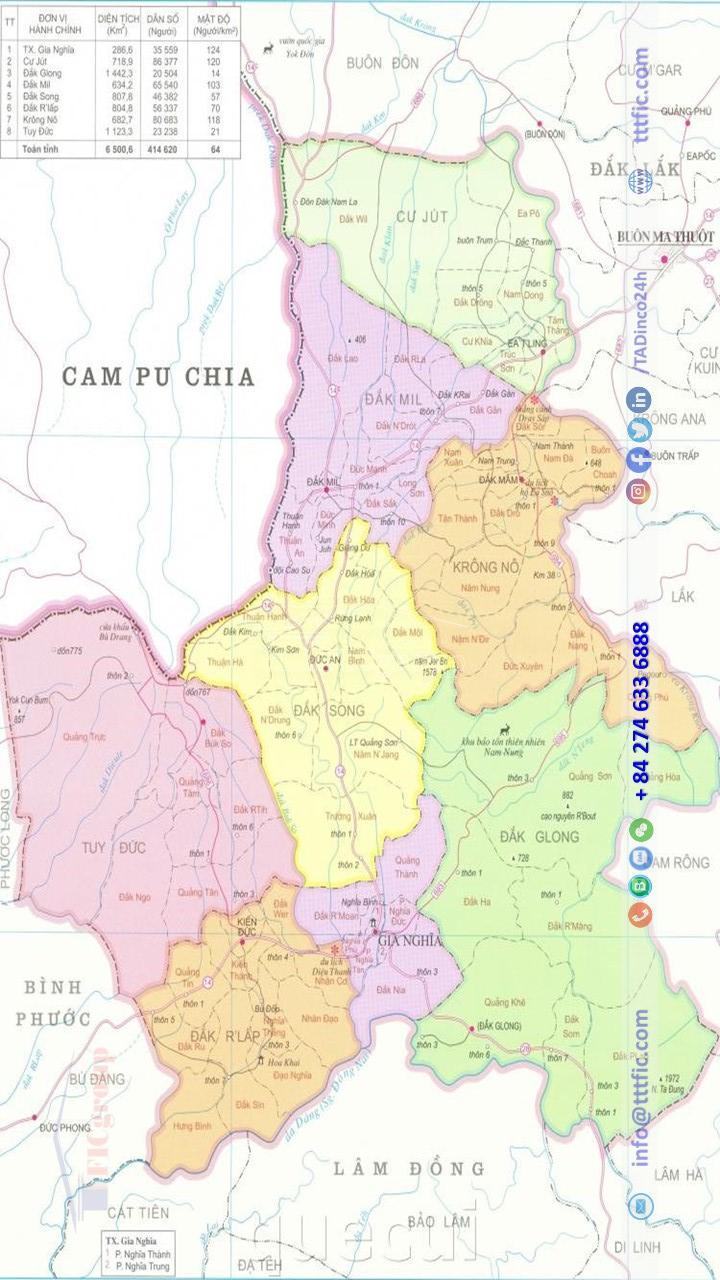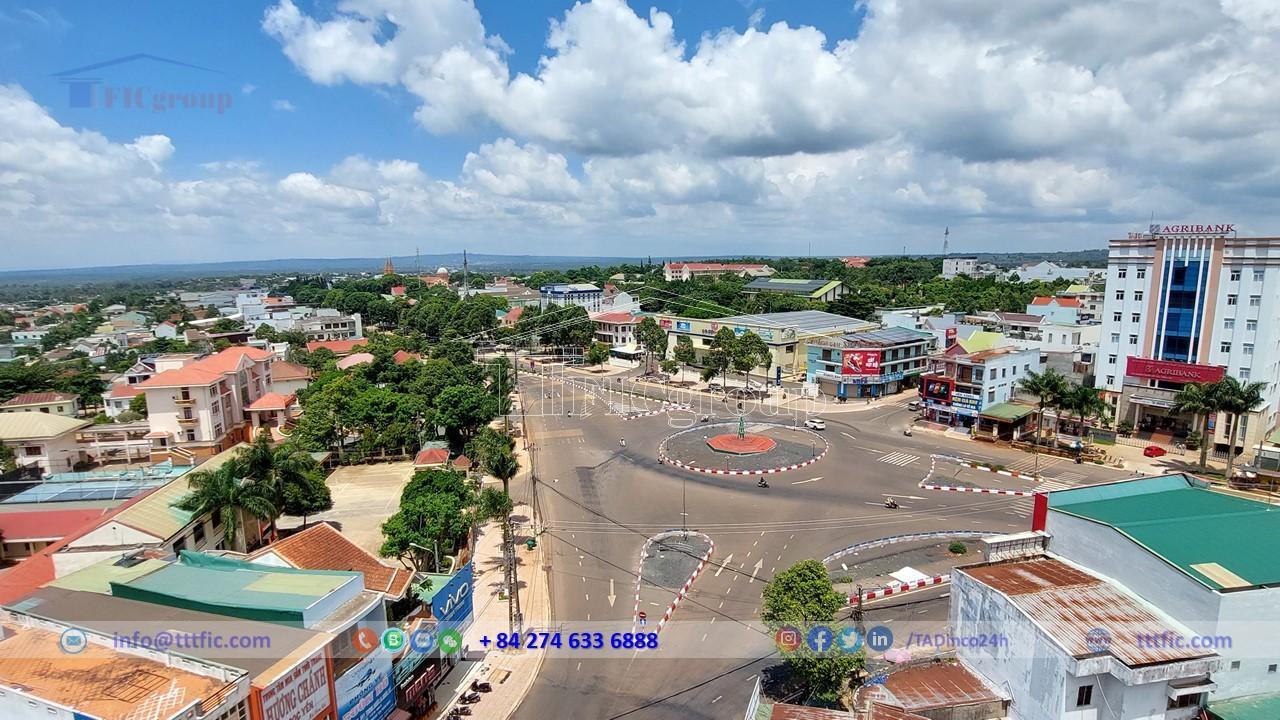
Tam Thang Industrial Park - Dak Nong
- Investor: The Tâm Thắng Industrial Zone Infrastructure Development Company
- Price: 30 USD/m2
- Area: 181 Ha
Situated in Vietnam’s southwestern gateway to the Central Highlands, Dak Nong spans coordinates from 11°45′ to 12°50′ north and from 107°12′ to 108°07′ east. The provincial capital, Gia Nghia, lies 125 km from Buon Ma Thuot city. Additionally, it is approximately 250 km south of Ho Chi Minh City, roughly 689 km north of Da Nang, and around 1358 km north of Hanoi.
Sharing its eastern and northern borders with Dak Lak province, Dak Nong also has its western boundary concurrent with Binh Phuoc province and Cambodia’s Mondulkiri, spanning about 141 km. Moreover, it borders Lam Dong province to the south and southeast.
In terms of extremities, Dak Plao commune in Dak Glong district represents the easternmost point of the province. On the other hand, Quang Truc commune in Tuy Duc district lies at the westernmost point. Further, the southernmost point is marked by Hung Binh commune in Dak R’lap district, while the northernmost point is Ea Po commune in Cu Jut district.
Lastly, Dak Nong houses two international border gates with Cambodia, specifically Dak Per located in Dak Mil district and Bup’rang in Tuy Duc district.

In 2021, Dak Nong’s economic growth was second in the Central Highlands and seventh nationally. Its GRDP reached VND 20,728 billion ($896.1 million), an 8.63% increase from the previous year. Per capita income was estimated at VND 59.61 million ($2,225). State budget revenue reached VND 2,847 billion, surpassing local estimates by 103.74% and exceeding the previous year by 112.25%.
Economically, agriculture, forestry, and fisheries made up 38.11% of the GRDP, while the industrial and construction sectors accounted for 18.74%. Services comprised 38.69%, with taxes and subsidies at 4.46%. The total food production was 317,500 tons, nearly meeting the target. Coffee production reached 140,069 tons, and 75% of rural households accessed clean water.
In 2022, the Provincial People’s Committee surpassed 11/11 socio-economic targets. GRDP growth rate was 7.59%, a slight increase over the plan. State budget revenue reached VND 3,475 billion, exceeding the plan by 15.8%. Total social investment capital was VND 19,280 billion, a 14.5% increase from 2021. The poverty rate decreased by over 3%, and the poverty rate among ethnic minorities fell by over 5%.
Retail sales and service revenues reached VND 19,312 billion, a 21% increase. Tourism arrivals in Dak Nong reached 480,000, a 280.6% increase. The province continued to focus on rural development, with three more communes meeting new rural standards. Social security, cultural, educational, environmental sectors, administrative reforms, digital transformation, and corruption prevention continued to receive attention, with positive changes noted. National defense, security, and social order were maintained.
As of April 1, 2019, Dak Nong’s population was 622,168, with 15.04% living in urban areas and 84.96% in rural areas. The gender distribution was nearly even, with males at 51.15% and females at 48.85%. The total fertility rate in 2018 was 1.82 children per woman, sustaining the replacement level. The average life expectancy in 2018 was 69.92 years, with males living an average of 67.11 years and females 72.9 years. By 2022, the urbanization rate reached 30%.
As of the same date, the province had 12 religions, with Catholicism being the most prominent, followed by Protestantism and Buddhism. Other religions, including Hoa Hao Buddhism, Minh Ly Dao, and Islam, had smaller followings.
According to the General Statistics Office of Vietnam, as of April 1, 2009, Dak Nong was home to 40 ethnic groups. The Kinh people were the most populous, followed by the Mnong, Nung, and Mong ethnic groups. Other ethnic groups included the Tay, Dao, Thai, Ma, E De, Hoa, and Muong.
By 2020, Dak Nong spanned 6,509.27 km², housing a population of 637,907, resulting in a population density of 98 people per km².

According to the 2011 health statistics, Dak Nong Province had 79 health care facilities under the Department of Health, including 8 health stations and 71 commune health stations. These facilities had 1029 beds, 258 doctors, 596 medical assistants, 859 nurses, and about 483 midwives.
Dak Nong General Hospital, the province’s main hospital, has infrastructure and equipment limitations. Consequently, patients often transfer to larger hospitals like Cho Ray Hospital and Da Nang Hospital. Others go to Bach Mai Hospital or the Central Highlands General Hospital. In response, the provincial health sector is enhancing human resources. They are also learning modern techniques and attending training courses from bigger hospitals.
The Department of Health consists of 14 units, including six provincial units: the Population and Family Planning Office, the Food Safety Office, the Provincial General Hospital, the Medical Examination Center, the Forensic Center, and the Disease Control Center. There are also eight district/city Health Centers. In total, the department has over 2,000 civil servants and employees, with an official quota of 2186/2156. Among these, there are 507 doctors (149 postgraduates), 11 public health graduates and masters, and 1668 other specialists.
The provincial general hospital has 380 beds, staffed by 411 healthcare workers (119 doctors, 24 pharmacists, 149 nurses, 32 technicians, and 87 other specialists).
The district level includes seven multifunctional health centers with 915 beds and 991 healthcare workers (249 doctors, 106 pharmacists, 261 nurses, 59 technicians, and 316 other specialists).
At the commune level, there are 71 communes, wards, and towns with 561 healthcare workers (85 doctors, 73 pharmacists, 148 nurses, and 225 other specialists).